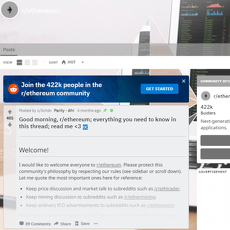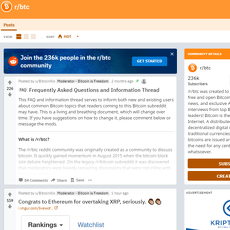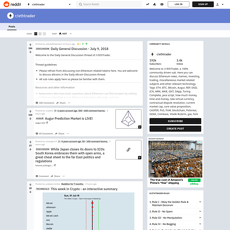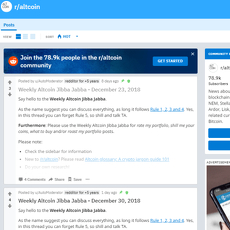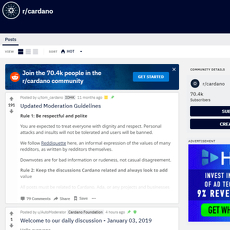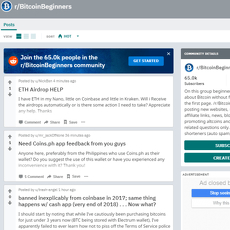r/CryptoMarkets Review
r/CryptoMarkets
www.reddit.com
r/CryptoMarkets Review Guide: How I Use Reddit’s Market Hub Without Getting Wrecked + FAQ
Ever wished you could read the crypto market’s mood in minutes instead of doom-scrolling Twitter for hours?
That’s exactly why I still keep r/CryptoMarkets in my daily rotation. It’s one of the fastest places to spot what retail (and a surprising number of pros) are watching, catch potential catalysts, and stress-test your ideas in front of a big audience. Used right, it saves time and helps you avoid bad takes. Used wrong, it’s a FOMO and shill factory.
Describe problems or pain
Most people jump into r/CryptoMarkets, get hit with hype and hot takes, and leave more confused than when they came in. Sound familiar?
- FOMO traps: A coin “breaking out” at 2 AM with 50 excited comments and a chart with no context. By the time you buy, it reverses. Not fun.
- Shills and hidden bags: Brand-new accounts hyping a microcap “before it 10x’s,” no risk section, and “DYOR” slapped on at the end. Classic.
- Conflicting TA: One thread says “ascending triangle to the moon,” another says “distribution top, rug incoming.” You’re left guessing who’s actually looking at the calendar or liquidity.
- Time sink: You scroll for an hour, save nothing useful, and miss the one thread that actually had the filings, on-chain data, or unlock schedule you needed.
If you’ve felt any of that, you’re not alone. Social sentiment can move crypto faster than almost any other asset class—there’s plenty of real-world proof. Musk’s tweets repeatedly moved BTC and DOGE in minutes (covered widely by Reuters), and researchers have shown that online mood can lead short-term financial moves (see early evidence in Bollen et al., 2011 on social mood and markets). The punchline? Attention matters. But attention without filters gets expensive.
Promise solution
Here’s the good news: when you know how to use r/CryptoMarkets, it turns from noise into a solid research accelerant.
- I’ll show you how the sub actually works (so you don’t miss the best threads).
- You’ll see which recurring posts matter and how to find them fast.
- You’ll learn simple filters that cut through hype and force better decisions.
- And you’ll get a quick framework to assess any post before you let it near your capital.
I treat r/CryptoMarkets like a real-time research feed, not a signal service. That mental shift alone saves a lot of pain.
Who this helps
- New and intermediate traders who want a quick market read without falling for loud narratives.
- Investors and researchers who need link discovery, macro context, and on-chain angles—fast.
- Busy folks who want to scan sentiment and catalysts in minutes, not hours.
What you’ll learn
- Which threads consistently carry signal (and how to find them quickly).
- Simple filters and trust signals that keep you from chasing noise.
- How to assess posts: author history, sourcing, risk talk, and counterarguments.
- Posting tips that attract smart pushback instead of low-effort replies.
- Red flags that almost always save you money when ignored.
Quick note
- This is not financial advice. Treat r/CryptoMarkets as a research tool, not a trade trigger.
- Never act on a headline. Ask for receipts: on-chain links, filings, code, or legit data.
- Write your invalidation before you hit buy. If a post doesn’t discuss risk, that’s your first red flag.
Want the fast-track on what the sub really is (and isn’t), plus the moderation signals that point you to the good stuff? Let’s start there—ready to see how to use r/CryptoMarkets without getting wrecked?
What r/CryptoMarkets is (and isn’t)
Overview and purpose
r/CryptoMarkets is Reddit’s market-centric crypto hub. Think less memes, more market talk: price action, macro, on-chain, TA/FA, catalysts, flows, and strategy. It’s where I take the market’s temperature in minutes—what retail is buzzing about, what analysts are watching, and which narratives are picking up steam.
“In fast markets, your attention is a currency. Spend it where receipts are required.”
On big days—ETF decisions, CPI prints, exchange incidents—you’ll see fast-moving threads with charts, options flow screenshots, and on-chain links. On quieter days, it’s a steady stream of levels, narratives, and research to sanity-check your watchlist.
What you’ll find
- Daily Market Discussion threads: real-time sentiment, key levels, catalysts people care about today.
- News and roundups: macro headlines (CPI, FOMC, ETF inflows), regulatory updates, ecosystem releases.
- TA posts: TradingView charts, trend/momentum setups, confluence zones, higher time frame context.
- On-chain and FA takes: supply unlocks, token emissions, L2 activity, validator metrics, treasury/fee data.
- Macro narratives: liquidity, yields, dollar strength, risk-on/off rotations, ETF flows.
- Altcoin discussions: catalysts, roadmaps, unlock schedules, exchange listings.
- Occasional AMAs and deeper research threads that pull in charts, code repos, or filings.
Example: the day spot Bitcoin ETFs were approved in January 2024, the top threads aggregated open interest maps, funding shifts, and intraday levels—useful for gauging positioning and likely liquidation zones. That’s the kind of “fast context” I expect here.
What you won’t (or shouldn’t) find
- Referral spam or promo codes disguised as “alpha.”
- Blatant shills and undisclosed bags pushing microcaps.
- Off-topic memes or low-effort “wen moon?” posts.
Mods are active and remove a lot of junk, but some slips through during hype waves. If a post screams “100x” without sources, it usually vanishes—or gets buried by skeptical comments.
Rules and moderation signals
If you want signal, follow the sub’s norms. A quick rule-of-thumb set I rely on:
- Read the rules in the sidebar before posting. Sources matter. Flair your post correctly. Referral links are no-go.
- Trust the stickies: Mod-pinned posts and megathreads (Daily, CPI/FOMC, ETF discussion) tend to attract better analysis.
- Flair filters are your friend: “TA,” “News,” “Discussion,” “On-chain,” “Macro,” “Question.” If you want charts or macro only, filter for it.
- Upvote velocity + comment quality: Fast, steady upvotes plus sourced, argumentative comments usually = higher-signal thread.
- Receipts over opinions: Links to TradingView, Dune, Glassnode, GitHub, filings or docs are green flags. Soft claims get soft trust.
Why this subreddit actually helps with price context
Beyond anecdotes, there’s evidence that what happens in social feeds affects crypto short-term dynamics. Multiple peer-reviewed and industry studies have reported that social-media sentiment—Reddit included—correlates with short-horizon volatility, trading volume, and sometimes returns. That doesn’t mean “Reddit calls tops and bottoms,” but it does mean a concentrated, time-stamped stream like r/CryptoMarkets is useful for spotting shifts in attention, narratives, and crowd positioning when it matters most.
Practical example you’ll see often:
- Funding and open interest snapshots posted under market threads when price accelerates.
- On-chain flows flagged when large wallets or exchange reserves move during catalysts.
- Event prep (CPI, unlocks, upgrades): people share levels, scenarios, and invalidation points, which helps structure risk.
Who tends to post (and how that shapes the feed)
- Retail traders comparing setups and sharing levels they care about today.
- Analyst-types who post curated dashboards or TA frameworks with clear rules.
- Builders and researchers chiming in on protocol mechanics, token design, or roadmap implications.
That mix is the point: broad enough to catch new ideas quickly, narrow enough to stay market-focused. If you’re scanning for catalysts and “what the crowd is actually trading,” this balance works.
How to read the room at a glance
I treat a thread’s first screen like a market snapshot:
- Title precision (timeframe, pairs, levels) beats hype. “BTC 1D: reclaim above 200D with rising OI—watch 200W confluence” is better than “We go up.”
- Source density: multiple linked charts/dashboards with timestamps is a stronger signal than a wall of text.
- Balanced pushback: smart disagreements in the top comments usually means the OP invited real scrutiny.
If that sounds like a lot to parse, don’t worry—I keep it fast and systematic.
Want my exact switches for turning r/CryptoMarkets into a high-signal feed? In the next section, I’ll show how I sort, filter flairs, and use search operators so you get the right threads at the right time without the noise. Ready to set it up in under five minutes?
How to set up r/CryptoMarkets for signal, not noise
Tune your feed
I want fast context without drowning in takes. Here’s how I set up r/CryptoMarkets so the right posts find me at the right time.
- Switch sorting based on market conditions.
- Volatile moves: sort by New to catch real-time catalysts (exchange outages, liquidation cascades, sudden policy headlines). When Binance paused certain conversions in late 2022, the earliest warnings showed up here minutes before mainstream outlets.
- Normal days: sort by Top (Today) or Top (This Week) for higher-signal roundups people already pressure-tested.
- Use Reddit search like a pro. I save custom searches as bookmarks so I’m one click from past deep-dives (restrict to the sub with restrict_sr=1).
- title:"funding rate" OR "open interest" — timing talk.
- title:SOL OR title:"Solana" — see high-signal Solana threads from the past year.
- site:coindesk.com OR site:cointelegraph.com OR site:github.com — posts with external sources/code.
- author:Glassnode OR author:SantimentFeed — follow specific posters when applicable.
- Filter by flair to focus. On desktop, use the sidebar’s “Filter by flair.” I keep TA, News, Discussion, and On-chain on, mute anything that distracts me. If your brain hunts headlines, kill the noise at the source.
- Save a “quick dashboard” of links. I keep a browser folder with:
- New, Top (Today), Top (Week)
- My three most-used searches (examples above)
- “Posts by” pages of 2–3 high-signal users I follow
- Optional helpers: Reddit Enhancement Suite (desktop) lets me tag users and quickly spot my “trusted voices” in long threads.
Why this matters: research shows attention and sentiment spikes often precede higher volatility. In crypto, that tends to mean sharper moves and sharper reversals. See peer-reviewed work like Kristoufek (2013) on attention and price, and Garcia et al. (2014) on emotion and Bitcoin bubbles. Fast context is an edge—if you can separate signal from heat.
Read smarter, faster
“Skim, verify, then care.” That’s my internal rule. Here’s the quick filter I use before I let a post influence my thinking.
- Check the author’s footprint in 20 seconds:
- Click their profile. Look at account age and recent history. Are they posting across quality subs or just microcaps?
- Read a couple of their comments. Do they link primary sources or repeat slogans? Substance beats swagger.
- Scan the comments first. Sort by “Best.” I look for:
- Sourced replies (links to on-chain dashboards, filings, GitHub commits, exchange status pages).
- Charts with context (timeframe, levels, invalidation). A lone arrow to the moon is decoration, not data.
- Credible pushback. If smart counterpoints exist and the OP engages thoughtfully, the thread’s usually worth my time.
- Demand receipts. If someone claims “active addresses up 200%,” I expect:
- A link to a chain explorer or analytics page.
- A timeframe and method (7D MA? unique addresses? sybil-adjusted?).
- Risks or caveats (airdrop farming, bridge loops, exchange churn).
- Use “pattern then proof.” When I see a pattern (e.g., funding flipping positive into resistance), I look for corroboration: options skew, open interest shifts, or a macro calendar risk ahead. Soft claim = soft conviction.
“In God we trust; all others must bring data.” — W. Edwards Deming
One more emotional guardrail: hype triggers FOMO; sources trigger patience. If a post makes your heart rate jump but shows no receipts, that’s your cue to breathe, not buy.
Engage the right way
Good questions get good answers. Vague questions invite noise. I write like I’m letting smart strangers audit my idea.
- Ask with context. Instead of “Thoughts on ARB?”, try:
- “I’m evaluating ARB on the 4H. Thesis: reclaim of 200D with rising perp OI looks like a trap if funding stays elevated into Friday’s unlock. Invalidation: close below 200D or funding resets. Looking for: on-chain flows or options data that support/kill this idea.”
- Share your risk and invalidation up front. You’ll attract serious replies, not cheerleading.
- Disclose your bag if you have one. Nothing builds trust faster.
- Save what works. Hit “Save” on high-signal comments and threads. On profiles, click “Follow” for posters who consistently show sources and admit uncertainty. I also keep a running note of usernames I trust (and a few I don’t).
- Give more than you take. If you use someone’s chart or idea, circle back with outcomes. You’ll build a feedback loop—and people will show up when you ask for help next time.
Set up the feed, read like a hawk, and engage like a pro—now you’re ready for the heavy lifters. Want the exact recurring threads I refresh every morning and the tools I use to validate claims in 60 seconds or less?
Threads and tools that do the heavy lifting
High‑value recurring threads
When I need fast, usable context, I don’t roam the whole subreddit—I camp on a few recurring threads that consistently carry signal. Here’s the short list and how I squeeze value out of each.
Daily Market Discussion (DMD)
This is where the real-time pulse sits: key levels, intraday catalysts, and which tickers are actually moving. During major events—CPI prints, ETF headlines, big exchange incidents—the DMD thread surfaces reliable sources within minutes and the comments pressure-test narratives fast.
How I use it:
- Scan the top comments for consensus levels and “receipt” links (charts, funding, OI). If multiple posters cite the same levels with charts, I pay attention.
- Watch for shifts in tone: when bears start posting risk management instead of victory laps, it often precedes a trend change.
- Open the linked dashboards immediately to validate claims before they cement into bias.
Quick filter: search “Daily Market Discussion” to find today’s thread.
Weekly TA/Strategy Megathreads
Cleaner charts, clearer frameworks, less noise. You’ll see multi-timeframe analyses, invalidation levels, and actual risk talk. It’s not about hot takes—it’s about process.
How I use it:
- Bookmark 2–3 chartists who are consistent about showing their invalidation. Over time, that becomes your early-warning radar.
- Look for confluence: anchored VWAP from cycle lows, 200D MA, weekly supply zones, and funding extremes lining up. Confluence > any single indicator.
- Note the timeframes. A weekly thesis can be perfectly right while your 15‑minute scalp gets smoked.
Quick filter: search “Weekly TA Strategy Megathread”.
News/Roundups
Fast aggregation of macro, regulatory, and ecosystem updates. Great for spotting catalysts and timeline risk (unlock schedules, ETF flows, upgrades).
How I use it:
- Flag events with precise timing: CPI, FOMC, token unlocks, hard forks, listing windows. Write them on your calendar—don’t trade into known fog.
- Cross-check headlines with primary sources: SEC filings, project GitHub, protocol forums, or press rooms.
- Save threads when ETF flow tables or unlock calendars are attached—you’ll reuse them all week.
Quick filter: search “news roundup”.
“In a market of opinions, show me your data.”
Tools you’ll often see referenced
These are the dashboards, charts, and trackers that pop up in the best comments. Learn them and you’ll cut your research time in half.
TradingView — tradingview.com
Use for: multi-timeframe charts, alerts, and clean execution plans.
Quick checks:
- Anchored VWAP from cycle low/high or key news candles to see where buyers/sellers reset risk.
- Relative Volume (RVOL) and Session Volume Profile to spot real participation vs. drift.
- Index charts (BTCUSD, TOTAL2) for bias, then your exchange pair for entries.
Dune Analytics — dune.com
Use for: custom on-chain dashboards (DEX volumes, protocol fees, stablecoin flows).
Starter dashboards:
- Bitcoin ETF flows (Hildobby) to contextualize price moves with actual spot demand.
- Search “stablecoin supply” and “DEX volume” to confirm risk-on/risk-off regimes.
Glassnode Studio — studio.glassnode.com
Use for: exchange balances, realized metrics (SOPR, MVRV), long/short cohort behavior.
Quick checks:
- Exchange Net Position Change: persistent outflows often coincide with risk appetite.
- SOPR > 1 rising suggests profit-taking pressure; falling through 1 can mark resets. Glassnode’s Insights cover this extensively.
Santiment — app.santiment.net
Use for: on-chain + social activity, funding, and developer activity proxies.
Quick checks:
- Spikes in social mentions without matching on-chain usage = headline risk.
- “Dev activity” is a proxy; cross-check with CryptoMiso and project repos.
Funding, OI, liquidations — CoinGlass, Laevitas
Use for: leverage maps, squeeze risk, and options term structure.
Quick checks:
- Funding Rate: negative funding + rising price + climbing OI = classic short-squeeze fuel.
- Liquidations: clustered liq levels mark magnets in violent moves.
- Laevitas: 25‑delta skew and IV term structure to see if options are pricing tail risk ahead of events.
Token unlocks and supply — TokenUnlocks, CryptoRank Unlocks
Use for: emissions and unlock timelines that impact supply and narratives.
Quick checks:
- Size of unlock relative to daily volume; if unlock >> volume, expect pressure unless managed.
- Who receives the unlock (team, investors, ecosystem) and historical sell behavior.
Repo activity and builders — Electric Capital Developer Report, project GitHub
Use for: long-term health checks. Sustained developer counts often correlate with resilience during drawdowns (Electric Capital’s reports detail this).
How I validate a claim (fast):
- “Funding is super negative; a squeeze is coming.” → Check CoinGlass funding on multiple pairs, confirm OI trend, and see if price is grinding up. If yes, squeeze risk is real; if price is flat and OI stagnant, it’s just talk.
- “Whales accumulating this alt.” → Open Etherscan/Solscan holders, look for top-holder balance changes; cross-check exchange inflows/outflows and DEX volumes on Dune. If wallets are distributions or CEX inflows are spiking, it’s not accumulation.
- “ETF flows are driving today’s pump.” → Open the Dune ETF flows dashboard. If net flows are small or negative, the story doesn’t match the data—treat it as narrative, not fact.
There’s decent research backing some of these checks. For example, options skew tends to rise before stress events, funding extremes often align with local reversals, and futures basis tracks risk appetite—topics covered frequently by Glassnode and K33 Research. I don’t trade the studies; I use them as context so I’m not surprised when markets react the “textbook” way.
Red flags to watch
If a thread or comment trips any of these, I raise the bar for evidence.
- “This will 10x” with no receipts. No risk section, no invalidation, no data. Pass.
- Undisclosed bags. Language like “sleeping giant,” “early before influencers,” and “marketing push soon.” Check account history for prior ticker spam.
- Referral or “DM me” links. Especially from fresh accounts using link shorteners. Report and move on.
- Cherry-picked wins. If a poster never shows losses or invalidations, you’re not seeing the full story.
- Brand-new accounts hyping microcaps. Created days ago, posting only in project subs or airdrop threads—hard no without verifiable on-chain distribution data.
- No timeframes. “Bullish” without specifying intraday vs. weekly is how people talk when they don’t plan to be accountable.
Two power tips I use constantly:
- Ask for links. If a claim is real, someone can point you to a chart, dashboard, or filing in under a minute.
- Use the Reddit bot “RemindMe!” in a comment (e.g., RemindMe! 7 days) on bold predictions. It keeps both you and the poster honest.
You’ve now got the threads and the tools. But what about the actual strategy you’ll keep seeing—TA setups, on-chain tells, macro cues—and how to tell which ones deserve your capital? Want a simple checklist to judge any strategy the moment you see it?
Strategy talk you’ll see (and how to assess it)
If you spend any time in market threads, you’ll see three big buckets of strategy: chart-based timing, fundamentals/on-chain, and macro flow talk. Each can help—if you know what to ask before you act.
“The goal isn’t to be right. The goal is to take bets where being wrong doesn’t wreck you.”
Common approaches
1) TA: levels, trend, momentum
- What it’s good for: timing and risk placement. TA won’t predict the future, but it can show where you’re likely wrong.
- What I check: market structure (higher highs/lows), key moving averages (200D/200W on BTC), RSI/MACD divergences, volume on breaks, and where liquidity sits (recent highs/lows).
- Sample thread claim: “BTC reclaimed the 200D MA. Breakout confirmed.”
- How I assess:
- Open TradingView and verify the reclaim on daily close, not just intraday.
- Check funding and open interest—if they’re spiking, breakout could be crowded and prone to fake-outs.
- Find the invalidation: e.g., “Daily close back below the 200D kills the setup.”
- Evidence note: Trend following has worked across many markets; the classic “time-series momentum” effect is well-documented in traditional assets (Moskowitz–Ooi–Pedersen, 2012). In crypto specifically, short-term momentum has also been observed (Liu & Tsyvinski, 2018), which is why basic trend rules can help.
2) FA/on-chain: revenue, usage, design, supply
- What it’s good for: filtering hype. A protocol printing real fees and users isn’t the same as one with only narrative.
- What I check: do fees accrue to the token? Emissions vs. buybacks/burns? Upcoming unlocks and vesting? Active users and retention? TVL quality (sticky or mercenary)?
- Sample thread claim: “Protocol X revenue up 200%—undervalued.”
- How I assess:
- Pull fees and revenue from sources like Token Terminal (does it flow to token holders or just LPs/validators?).
- Open TokenUnlocks. If 15–30% of supply is vesting in the next 90 days, that 200% revenue pop might get steamrolled by supply.
- Check on-chain activity consistency (are daily users and tx fees up for weeks, or was it a weekend one-off farm?).
- Real-world pattern: Big unlocks often pressure price into the event, then sometimes mean-revert after. Plan, don’t guess.
3) Macro: rates, liquidity, flows
- What it’s good for: knowing when the current runs with or against you. Macro can swamp good micro setups.
- What I check: CPI/FOMC calendar, DXY and rates trend, stablecoin net issuance, and ETF flows (spot BTC ETF inflows/outflows via trackers like Farside).
- Sample thread claim: “Soft CPI = crypto up.”
- How I assess:
- Historical reaction isn’t linear. Sometimes crypto sells initial prints, then trends after the dust settles. Expect whipsaw and size down into binary prints.
- Watch liquidity proxies (stablecoin growth and ETF net flows) to confirm if the move has fuel.
Risk management basics people actually use
Strategies get attention; risk pays the bills. Here’s the stuff that keeps me in the game when a loud thread is wrong.
- Position sizing: Define risk in dollars, not vibes. If I’m willing to lose 1% of my stack on an idea and my stop is 5% away, the position size is 1% ÷ 5% = 20% of portfolio for a spot trade. On perps, I size smaller due to liquidation risk.
- Invalidation first: Write the line that proves the thesis wrong before I enter. “ETH thesis dies on a daily close below $X with rising OI.” If that happens, I’m out—no arguments.
- Stops that make sense: Use structure-based stops (below swing low/higher timeframe level) or volatility-based (ATR multiple). I avoid clustering right at obvious equal lows/highs where stop hunts live.
- Avoiding overleverage: If the invalidation is 8% away and I’m on 10x, I’m basically begging for liquidation. Most blown accounts weren’t “wrong ideas,” they were wrong leverage.
- Event-aware entries/exits:
- Listings: new exchange listings often do “pop then mean-revert” unless the cycle is insane. I plan partial take-profit into the initial wick.
- Unlocks: size down ahead of large emissions; look for post-event stabilization to re-enter if the thesis still stands.
- Upgrades: buy rumor/sell news is real. For EVM upgrades, I watch gas/fee impact and whether utility actually improved a week later, not just day one.
Quick reality check: Most threads won’t include a risk plan. If the author can’t say where they’re wrong, they’re not leading— they’re cheerleading.
A simple research workflow for any post
When a hot post hits my screen, I run it through the same filter. Fast, boring, effective.
- 1) Identify the claim: What exactly is being predicted or implied? “SOL to $X by month-end because TVL up and ETF rumor.”
- 2) Check the receipts: Verify every stat. Chart the level yourself. Pull TVL/users from a trusted dashboard. Confirm the rumor has a named source.
- 3) Hunt opposing views: Search the comments for pushback. Open another thread with the opposite thesis. If there’s no credible counter, you haven’t researched— you’ve subscribed.
- 4) Fit to your plan: Does this idea align with your timeframe and toolbox? A weekly setup is useless if you only trade intraday.
- 5) Write your risk: Position size, invalidation level, expected catalysts, and where you’ll take profits. If it doesn’t fit on one note, it’s too complicated for a rushed trade.
- 6) Decide “act or archive”: If the edge isn’t clear, I save the post, set a price alert, and revisit. Patience is a position.
Two quick, real-world examples
- Chart setup: “BTC breaking range high with funding neutral.” I confirm the break on daily close, check that OI isn’t ballooning, place a small position with a stop below mid-range, and plan to add only if retest holds. If funding spikes before confirmation, I reduce size.
- Fundamental pop: “DEX Y revenue surges.” I verify on a data site that fees accrue to token holders (not just LPs), check emissions for the next 60–90 days, and only consider a position if net supply isn’t exploding. If a big unlock is due next week, I switch to a post-event plan.
One last thought: strong opinions are fine if they’re loosely held. The market doesn’t care how convincing a thread sounds—only how disciplined your plan is when it’s wrong.
Now, everyone keeps asking the same thing: can you actually make $100 a day doing this without going broke—or is that another Reddit myth? I’ve got a straight answer and a few traps to avoid next…
FAQ: r/CryptoMarkets and the money questions everyone ask
Subreddit-focused questions
Is r/CryptoMarkets good for beginners?
Yes—if you use it like a research springboard, not a signal feed. Stick to the Daily Market Discussion and weekly megathreads. Ask specific questions, share a chart or two, and ignore anything that sounds like a guaranteed win.
Quick starter workflow I use:
- Open the Daily Market Discussion → skim top comments for levels and catalysts.
- Search the sub for a ticker with title:[ticker] and sort by Top (This Week) to find past DDs.
- Save 2–3 threads that have sources, then verify on your own tools before forming an opinion.
Can I post my chart or thesis?
Absolutely—just show your work. When I post, I include:
- Timeframe (e.g., 4H swing, not scalp).
- Key levels (support/Resistance, invalidation).
- Why now (event, funding, OI shift, on-chain spike, narrative).
- Receipts (TradingView link, on-chain dashboard, filings, code).
“Long SOL 4H if it reclaims $X with funding normalizing; invalidation below $Y; watching net CEX inflows and options skew into Friday.”
How do I avoid shills?
Three checks in 30 seconds:
- Account history: New account + only posts about one microcap = hard pass.
- Sources: If there’s no chart, no data, and no risk section, I scroll.
- Pushback: Read the top counter-arguments. Good posts survive scrutiny. Weak ones fold fast.
Extra tip: use Reveddit to see if a user’s posts get removed often. It’s a quick mod-signal proxy.
Money questions traders keep asking
Can you make $1,000 a day with crypto?
Possible during big volatility with meaningful capital, a proven edge, and strict risk management. But consistency is rare. The research on day trading is brutal: studies of active traders show the majority underperform or lose money, with a tiny fraction achieving persistent profits. For example, academic work on Taiwanese day traders found only a small group were consistently profitable long term, while most lost money over time (Barber, Lee, Liu, Odean). The SEC also flags day trading as high risk with significant drawdown potential (SEC Investor Bulletin).
Reality check math: If you aim for $1,000/day with a 1% daily target, that implies ~$100k deployed with tight risk and frequent opportunities. Slippage, fees, and variance will test you. Chasing a daily dollar goal tends to push people into overtrading—my rule is to size positions by risk, not by income targets.
Can I make $100 a day from crypto?
More realistic for a skilled trader, but still not “easy money.” Think in % terms, not dollars. $100 is 0.5% on $20k or 1% on $10k. On some days, the market won’t give you a clean setup—forcing trades is how accounts bleed. If you’re still building, track your setups in a journal and aim for repeatability, not a daily quota.
What is the 30-day rule in crypto?
In the UK, when you sell and rebuy the same asset within 30 days, the trade can fall under share matching rules for capital gains calculations. HMRC treats crypto as an asset for CGT, so the pooling and 30-day matching concepts apply. Check current HMRC guidance before filing: Cryptoassets: tax for individuals.
In other jurisdictions, rules differ. For example, in the U.S., crypto has historically been treated as property, and the traditional “wash sale rule” for securities has not applied to crypto. That said, tax guidance can change—confirm with up-to-date official sources or a tax professional in your country.
Which cryptocurrency is predicted to explode?
No one knows. I refuse “next to explode” predictions without a framework. I run a simple checklist:
- Adoption and fees: Is there real usage and revenue? (Check Token Terminal/Messari)
- Token design: Emissions, unlocks, and who gets paid to hold or sell.
- Security and throughput: Does it do something better, and safely?
- Flows and timing: ETF/macro/liquidity that can actually move the tape.
When a thread screams “undervalued,” I pull up on-chain dashboards, check unlock calendars, and look for opposing views in the comments. If there’s no clear risk section, I assume the author didn’t think it through.
Extra quick hits I’m asked all the time
- How many trades per day is “too many”? When your average loss grows and your thesis shrinks. Most profitable journals I’ve seen concentrate on a few A+ setups a week, not dozens per day.
- Is leverage required? No. It magnifies both edges and mistakes. If your thesis only “works” at 10x+, it’s probably not robust.
- Best way to get feedback on a thesis? Post a chart with your invalidation, add 2–3 data receipts, and ask one pointed question. The sub responds well to specifics.
Resources I recommend
Here’s a starter bookmark that I keep one click away when a thread sparks an idea: Starter research stack. Build it out with your favorite on-chain dashboards, chart layouts, options/funding tools, and local tax references so you can verify claims fast.
Want the exact daily checklist I use to turn this sub into a repeatable edge—without doomscrolling or FOMO trades? That’s next.
Should you use r/CryptoMarkets? Here’s how I use it as a daily edge
I keep r/CryptoMarkets in my daily flow because it speeds up my read on the market. It’s not a crystal ball, but it’s a sharp lens on sentiment, catalysts, and which narratives are heating up. Used intentionally, it saves time and helps me avoid the classic “saw it on X and aped” mistakes.
Best-practices checklist
- Skim the Daily Market Discussion, then sort by Top (Today).
How I do it: I open the Daily thread first for levels, options chatter, and catalysts people are tracking. Then I flip to Top (Today) to find 2–3 posts that earned fast upvotes and solid comments. That combo gives me both live sentiment and curated signal without the doomscroll.
- Save 2–3 quality posts per session; verify with your own tools.
Example: If someone flags unusual BTC options flow or a chunky perp funding skew, I’ll save it, then cross-check on Deribit, Laevitas, or Coinglass. If a thread highlights a token unlock, I confirm on TokenUnlocks. When a macro claim pops up, I look at the source and check the next data release on the BLS CPI calendar or the FOMC calendar. My rule: if I can’t verify it in under two minutes, I don’t give it my attention.
- Never trade a headline. Write your invalidation first.
Headlines are traps. On Oct 16, 2023, a false “BTC spot ETF approved” blast sent Bitcoin up fast, then it snapped back just as quickly. That single rumor whipsawed anyone who chased it without a plan (covered by outlets like Reuters). I always jot down my invalidation level before I act. If price tags that level, I’m out—no debate.
- Respect event risk (CPI, FOMC, unlocks, listings).
Crypto’s correlation to macro jumps around key prints. Data providers have shown repeated volatility spikes around 8:30 ET CPI and 14:00 ET FOMC decisions (you can track probability shifts via the CME FedWatch Tool). On token side, big unlocks often change liquidity and behavior for days. For listings, the “sell the news” risk is real—if a thread is euphoric, I assume I’m late and size down or stand aside.
Process beats prediction. My default: read, verify, write the risk, then decide. If I can’t write the risk in plain English, I don’t touch it.
My quick workflow in practice
On a normal day (5–10 minutes):
- Open the Daily Market Discussion. Note key levels mentioned by multiple posters (confluence matters).
- Sort by Top (Today). Save 2–3 posts with sources, charts, or on-chain receipts.
- Cross-check the best idea with my own dashboards. If it holds up, I tag it to revisit at NY open or after the next data print.
On a macro day (CPI/FOMC):
- 8:10 ET: Scan the Daily thread for consensus expectations and likely “pain trades.”
- 8:25 ET: Set alerts. No fresh risk until the number hits and spreads normalize.
- 8:35–8:45 ET: If a post nails the why behind the move (not just the what) and sources it, I save it for the replay. I still won’t chase a candle; I wait for my entry plan.
On an unlock/listing day:
- Check the size and recipient profiles on TokenUnlocks. If the cliff is large and allocations are to early investors/teams, I expect volatility and shift to planning, not predictions.
- Use r/CryptoMarkets to gauge if the market is positioned the same way. If everyone agrees, I get extra cautious.
What r/CryptoMarkets can’t do for you
- It won’t give you certainty, guaranteed picks, or perfect timing. Even great threads are just hypotheses. Markets change faster than comment sections.
- It’s a lens, not a trigger. The edge is in your filtering, verification, and execution. Screenshots and narratives won’t manage your risk for you.
Final thoughts
Used intentionally, r/CryptoMarkets is a powerful companion: fast context, fresh ideas, and a stress test for your thinking. I treat it like a research feed. I save the best posts, verify claims with my own tools, write my risk first, and keep one eye on the calendar for macro and token events.
That simple routine has helped me catch catalysts early, avoid headline traps, and spend less time chasing noise. If you want a daily edge from the sub, keep it tight: skim smart, bookmark the good stuff, measure twice, click once.




